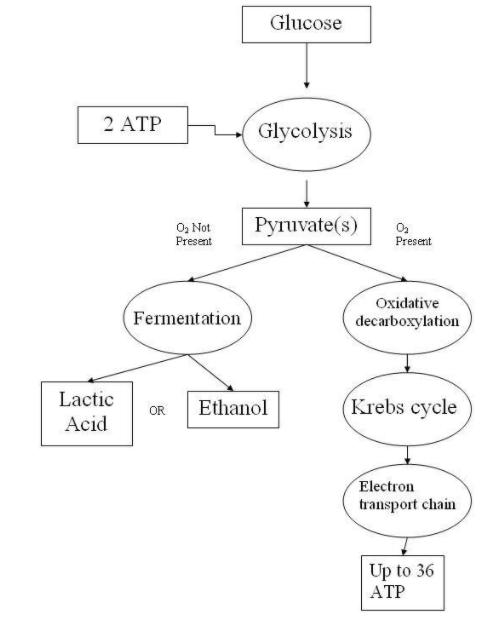
Define Cellular Respiration.
Answer
477k+ views
Hint: When you are trying to lift a heavy bag or running to catch a bus or even reading a book. All these functions require energy in different amounts, which is provided to our muscles and other body parts through respiration. This helps us in performing at the cost of energy produced from the food that you intake.
Complete answer:
Respiration in a living being is one of the fundamental processes that ensure their survival. To survive, we need energy, and breathing makes sure we receive while performing any work.
- It occurs in all living organisms.
- The products of cellular respiration are water and carbon dioxide.
- Electrons carrier are: ${FADH}_2 $ and $NADH$
- The metabolic process of cellular respiration is catabolic and reactants is oxygen + glucose
- Location of cellular respiration is Mitochondria and energy source is glucose.
Equation of cellular respiration is:
$C_6 H_{12} O_6 { + 6O}_2 \to {6CO}_2 { + 6H}_2 O$

The respiration occurring at the cellular level wherein the cells produce energy by combining oxygen with food molecules is called cellular respiration.
Cellular respiration helps in providing the body with energy to carry out regular tasks. Therefore, it is evident that in order to survive, cellular respiration has to take place at times.
In simple words, the cells turn the food that you intake into energy.
On oxidation, the energy released through carbohydrates and other vital substrates gets absorbed in ATP. Nevertheless, a fraction of energy is lost as heat amidst the process.
Additionally, Glycolysis and oxidation of pyruvic acid take place during cellular respiration. It is expressed as
$C_6 H_{12} O_6 { + 6O}_2 \to {6CO}_2 { + 6H}_2 O $.
Note: During the simultaneous process of oxidative phosphorylation, ATP molecules are produced from the oxidation of carbohydrates. Subsequently. Synthesised ATP is used during stages of the metabolic process.
Complete answer:
Respiration in a living being is one of the fundamental processes that ensure their survival. To survive, we need energy, and breathing makes sure we receive while performing any work.
- It occurs in all living organisms.
- The products of cellular respiration are water and carbon dioxide.
- Electrons carrier are: ${FADH}_2 $ and $NADH$
- The metabolic process of cellular respiration is catabolic and reactants is oxygen + glucose
- Location of cellular respiration is Mitochondria and energy source is glucose.
Equation of cellular respiration is:
$C_6 H_{12} O_6 { + 6O}_2 \to {6CO}_2 { + 6H}_2 O$

The respiration occurring at the cellular level wherein the cells produce energy by combining oxygen with food molecules is called cellular respiration.
Cellular respiration helps in providing the body with energy to carry out regular tasks. Therefore, it is evident that in order to survive, cellular respiration has to take place at times.
In simple words, the cells turn the food that you intake into energy.
On oxidation, the energy released through carbohydrates and other vital substrates gets absorbed in ATP. Nevertheless, a fraction of energy is lost as heat amidst the process.
Additionally, Glycolysis and oxidation of pyruvic acid take place during cellular respiration. It is expressed as
$C_6 H_{12} O_6 { + 6O}_2 \to {6CO}_2 { + 6H}_2 O $.
Note: During the simultaneous process of oxidative phosphorylation, ATP molecules are produced from the oxidation of carbohydrates. Subsequently. Synthesised ATP is used during stages of the metabolic process.
Recently Updated Pages
Master Class 11 Economics: Engaging Questions & Answers for Success

Master Class 11 Business Studies: Engaging Questions & Answers for Success

Master Class 11 Accountancy: Engaging Questions & Answers for Success

The correct geometry and hybridization for XeF4 are class 11 chemistry CBSE

Water softening by Clarks process uses ACalcium bicarbonate class 11 chemistry CBSE

With reference to graphite and diamond which of the class 11 chemistry CBSE

Trending doubts
What are the elders in Goa nostalgic about class 11 social science CBSE

Define least count of vernier callipers How do you class 11 physics CBSE

Write the differences between monocot plants and dicot class 11 biology CBSE

Which of the following is not a feature of the election class 11 social science CBSE

The mass of oxalic acid crystals H2C2O42H2O required class 11 chemistry CBSE

How many squares are there in a chess board A 1296 class 11 maths CBSE




